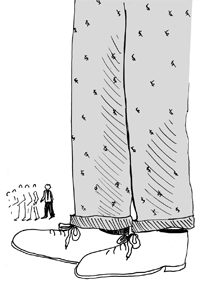STRANGE BUT TRUE- High hopes: When are billionaires 10 miles tall?

DRAWING BY DEBORAH DERR McCLINTOCK
Q. Imagine the world's people going by in single file, starting with the heightless and proceeding gradually to the very tallest. The procession takes a full hour to pass, but for the first 20 minutes no one is visible, then at about 30 minutes the first dwarfs appear and not until 48 minutes do we see the first average-height people. In the final few minutes the giants loom up, including the tallest whose heads we can't see. Last come several individuals whose heights are truly breathtaking. What's being depicted here? –Y. Ming
A. This is Dutch economist Jan Pen's classic symbolic representation of the world's distribution of money, with people's heights proportional to their wealth, say Michael Blastland and Andrew Dilnot in The Tiger that Isn't: Seeing Through a World of Numbers. Those invisible parade leaders have either negative wealth (debtors) or no wealth (height) at all. After the dwarfs pass, at around 48 minutes those of average height and wealth appear, with three-fourths of the world's people having already gone by. The very last individuals– such as mega-billionaires Bill Gates, Warren Buffett, John Paul Getty– stand at least 10 miles tall. Averages here don't mean much, as just one billionaire can shift the average more than thousands of poor people.
"They have this effect to the extent that 80 percent of the world's population has less than average," say the authors.
Q. What's probably the most useful word of universal communication ever devised, recognizable and pronounceable in almost every language on earth? This protean word can play as five different parts of speech– noun, verb, adjective, adverb and interjection. Some even add the interrogative, okay? –N. Webster
A. Professor Allen Walker Read tracked down the world's first printing of okay– all correct– to the Boston Morning Post in 1839, part of the craze of the day for "loopy initialisms and facetious misspellings," like today's FYI and TGIF, says Richard Lederer in A Man of My Words.
Echoing the "Oll Korrect" initialism, okay became the political rallying cry for the "Old Kinderhook" Club and its 1840 re-election campaign of President Martin Van Buren, born in Kinderhook, New York. Van Buren was defeated, but the word honoring his name went on to become, in H.L. Mencken's words, "the most shining and successful Americanism ever invented."
Q. You've been playing amateur hockey for years but wonder now about your chances of making it to the pros. Wouldn't it be easier to win the lottery and get rich that way? –J. Frost
A. The odds here are determined by the ratio between the number of National Hockey League (NHL) players and the number of guys aspiring to make it, says Alain Hache in The Physics of Hockey. Let's use Canadian statistics, since Canadians are a slight majority (about 55 percent) in the NHL, and almost every Canadian boy has put on a pair of skates and shot a puck at one time. In all, there are about 400 Canadians in the League, so that's 400 successes out of about 3.3 million potentials in the 20-35 age group, or 1 of every 8,300. But realistically we shouldn't count them all since not all kids have the same opportunity or interest.
Now if you eliminate a quarter of the kids, the odds go to about 1 in 6,000. "In other words, 0.02 percent of all serious amateur hockey players eventually make it to the big league. Not as bad as we thought! In fact, it's far better than the chances of winning a big lottery," Hache says.
Still, the chances of becoming another Wayne Gretsky or Mario Lemieux (who shows up about once a decade) are more like 1 in 2.5 million, posing lottery-like odds. So keep your eye on the prize of just making it to the NHL, staying heartened by the 1-in-6,000 figure, as you practice, practice, practice.
Q. As between your Brooklyn lover and Bronx lover, you can never decide. So you follow fate, hopping the subway at random times each day, taking whichever lover's train comes first. Since you've been assured each one comes every 30 minutes, your love should be 50-50 over time. Two satisfied paramours! Will train potluck keep your romance on track? –G. O'Brien
A. You thought so, but Ms. Brooklyn wound up seeing you too much, Ms. Bronx not enough, dulling Cupid's arrows. Oh my, your bi-polar heart is breaking! What went wrong?
Nobody told you that while both trains indeed come every 30 minutes, the Brooklyn train comes always five minutes after the Bronx train. So for every 25-minute interval where you can chance upon a Bronx train, you have only a 5-minute interval to chance upon a Brooklyn train.
Love derailed 5-to-1. Go figure! (from Innumeracy, by John Allen Paulos)
Send Strange questions to brothers Bill and Rich at [email protected].
#